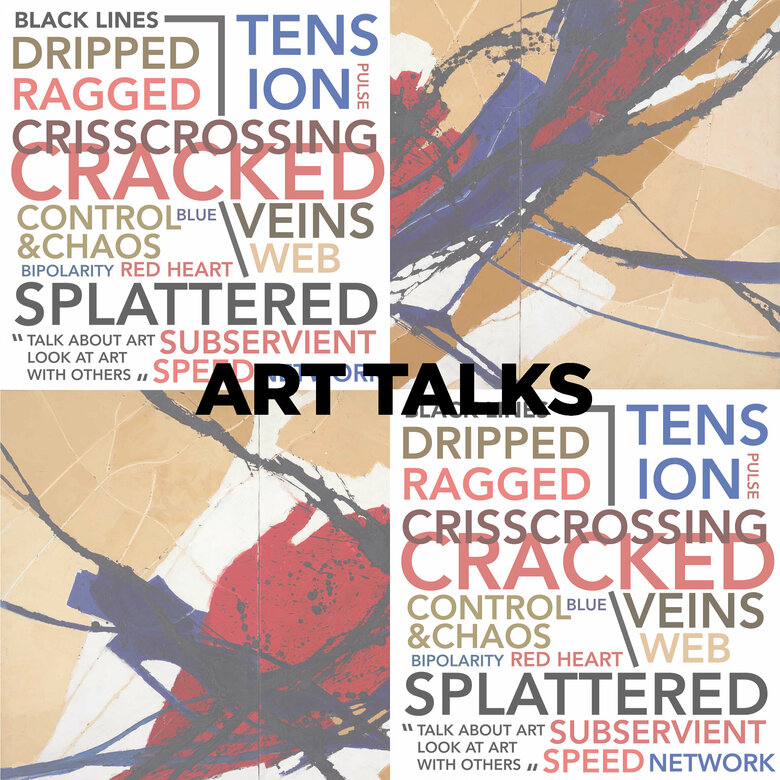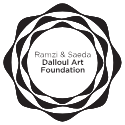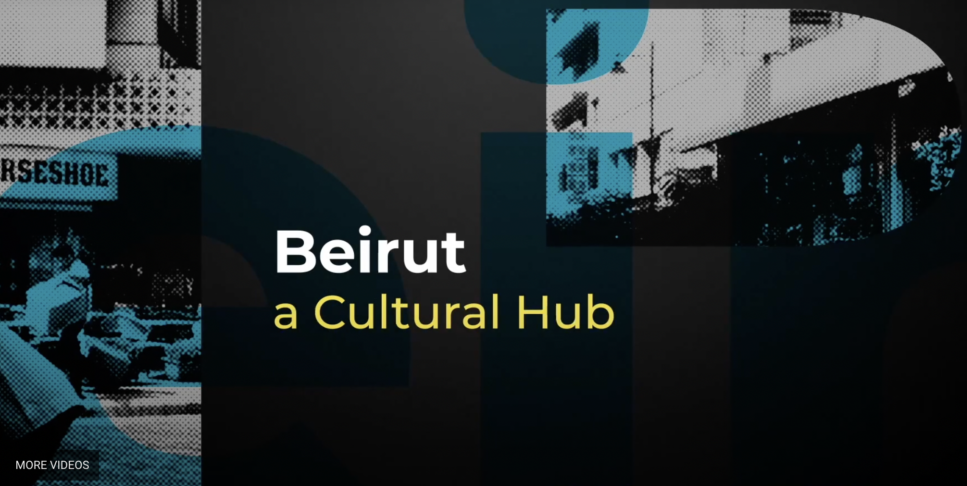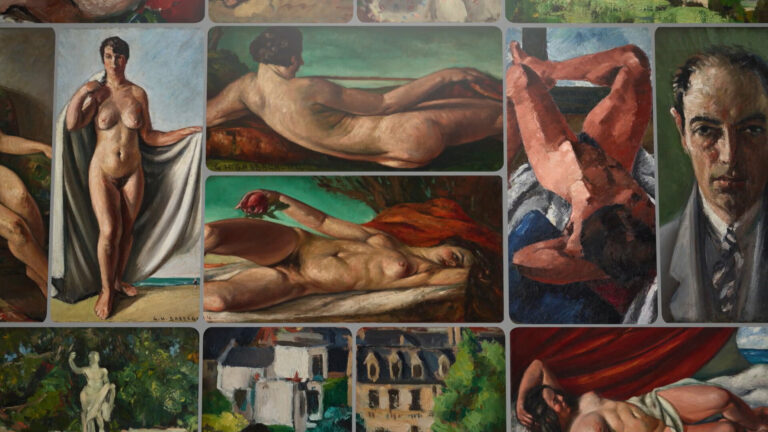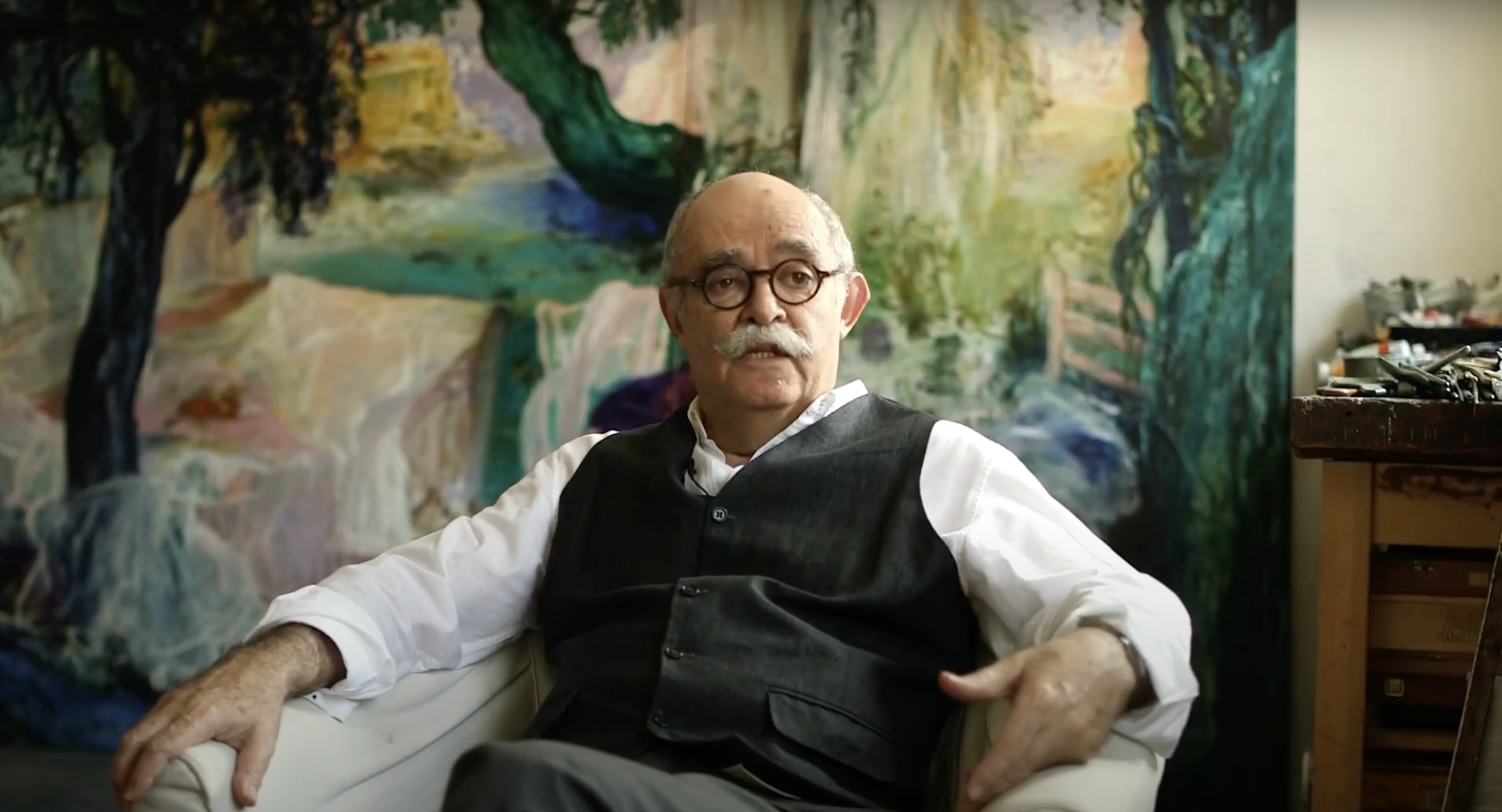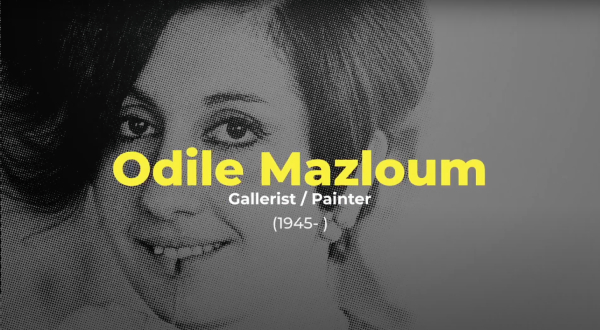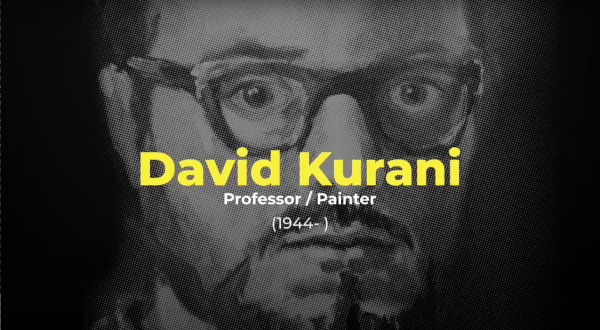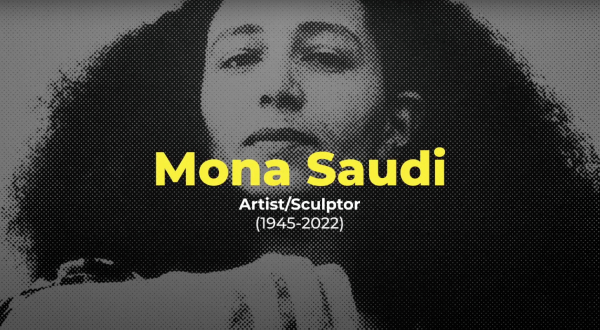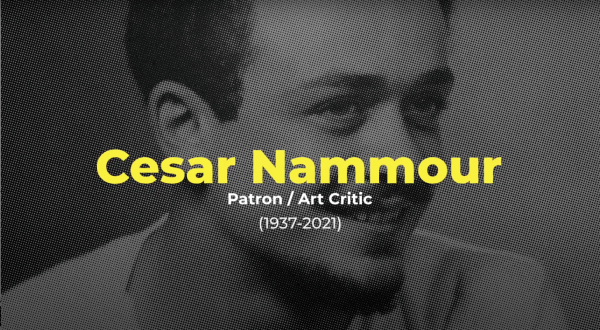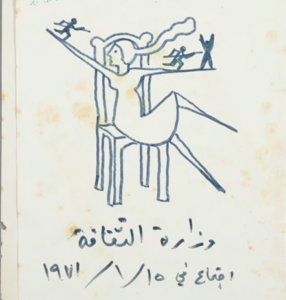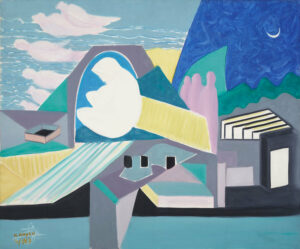ART TALKS
Check out some of DAF's latest Arab Artist Biographies
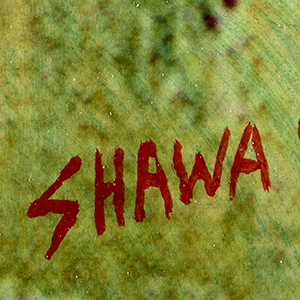
Laila Shawa
Laila Shawa was born in 1940 to a wealthy Gazan family. As a child, she was curious about art, but per her own description, her career as an artist started with a happy coincidence. In the mid-1950s, she was enrolled in the American University of Cairo as a student of political science and sociology when she had tea with her father and a family friend. Read More >>
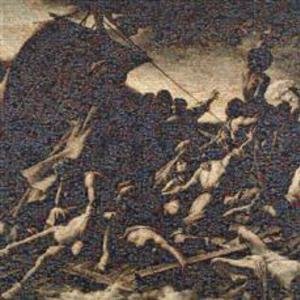
Kader Attia
Born in the Parisian suburb of Seine-Saint-Denis, France, in 1970 to an Algerian family originally from the mountainous areas around the Algerian city of Constantine, Kader Attia grew up between two countries and cultures. He studied at the École Supérieure des Arts Appliqués Duperré and the École Supérieure des Arts Décoratifs both in Paris. Read More >>
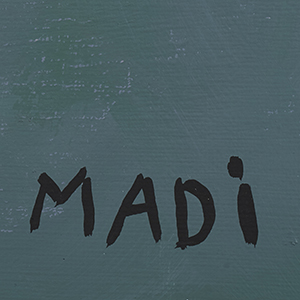
Hussein Madi
Hussein Madi was born in Chebaa, a town on the southeastern tip of Lebanon, in 1938. He spent his summers following his paternal grandfather into the orchards, observing him perform with talent, diligence, and mastery of his daily farming, carpentry, or blacksmith chores. From his stoic and wise grandfather Read More >>

Samia Halaby
A leading abstract visual artist, Samia Halaby, was born in 1936, in Jerusalem, Palestine. Halaby and her family relocated to Lebanon during the Nakba, Palestinian exodus in 1948. By then, most of the Palestinian land was occupied, and the Israeli state was declared.
Read More >>

Yasmina Hilal
Yasmina Hilal was born in Beirut, Lebanon in 1996. She is a Lebanese-American collage artist and photographer, whose work is influenced by and concerned with fashion. This is no surprise, considering that her grandmother owned a clothing store in Beirut called Beverly Hills, in the 1960s. Read More >>
"I trust my Eyes then my Hands.
I trust my Hands and my Heart." 🕊️
— @saraaboumradart
`La Danse du Soir` (2021) by Lebanese artist Sara Abou Mrad is part of the Matilda series, exploring femininity, sensuality, and eroticism.
Matilda, the protagonist of many of the artist’s pieces, symbolizes female sensuality and fragility. She is represented here in her purest form: nude and connecting intimately with the world around her.
Explore this artwork at the Hope in an Age of Dystopia exhibition, open until August 15 (Tuesdays to Fridays 11AM - 5PM, Saturdays 10AM - 1PM). Book your visit via the link in our bio.
La Danse du Soir (Collection Matilda), 2021
Medium: Acrylic on canvas
155 x 120 cm
#DAFBeirut #ArabArt #ArabArtists #Exhibitions #WomenArtists #LebaneseArtist #Surrealism #ArabWomenArtists
Jul 24

"I trust my Eyes then my Hands.
I trust my Hands and my Heart." 🕊️
— @saraaboumradart
`La Danse du Soir` (2021) by Lebanese artist Sara Abou Mrad is part of the Matilda series, exploring femininity, sensuality, and eroticism.
Matilda, the protagonist of many of the artist’s pieces, symbolizes female sensuality and fragility. She is represented here in her purest form: nude and connecting intimately with the world around her.
Explore this artwork at the Hope in an Age of Dystopia exhibition, open until August 15 (Tuesdays to Fridays 11AM - 5PM, Saturdays 10AM - 1PM). Book your visit via the link in our bio.
La Danse du Soir (Collection Matilda), 2021
Medium: Acrylic on canvas
155 x 120 cm
#DAFBeirut #ArabArt #ArabArtists #Exhibitions #WomenArtists #LebaneseArtist #Surrealism #ArabWomenArtists
...
These two installations, part of a project created by Lebanese artists Joana Hadjithomas (@abboutjoana) and Khalil Joreige between 2018-2022, propose several possible curatorial frameworks for an exhibition at the anticipated "space museum." The works bring together two major Lebanese cultural and scientific projects of the 1960s: First, the Rachid Karameh International Fairground in Tripoli, Lebanon, designed by Brazilian architect #OscarNiemeyer between 1962 and 1967. Second, The Lebanese Rocket Society, addressed in the award-winning documentary `The Lebanese Rocket Society. The Strange Tale of the Lebanese Space Adventure, 2012`, directed by Hadjithomas and Joreige.
The documentary narrates the story of the short-lived student society at Haigazian University in the 1960s, who tested and launched rockets in an attempt to conquer space. It includes an alternate history animation sequence that features the Lebanese Rocket Society`s own Space Museum.
While both these projects were interrupted by the Lebanese Civil War (1975-1990) before reaching their completion, the artworks reflect the same drive without straying into nostalgia: anti-imperialism, desire for change, human progress, scientific knowledge, and a look toward the future.
These `scenarios` or exhibition plans, represented as 3D-printed slabs ( in concrete and bronze), are not just curatorial frameworks for the museum`s `imaginary` exhibition. They are windows into a future that could have been, a future that still inspires and intrigues us.
This artwork is part of Hope in an Age of Dystopia exhibition, at DAF, open until August 15: Tuesdays to Fridays 11AM - 5PM Saturdays 10AM - 1PMTo book a visit, click the link-in-bio.
Scenario For a Space Museum | Scenario 4, 2018 - 2022
Medium: Bas Relief, Concrete
Edition Number: 4
32 x 72 x 4 cm
Scenario For a Space Museum | Scenario 1, 2018 - 2022
Medium: Bas Relief, Bronze
Edition Number: 2
32 x 73 x 5 cm
#DAFBeirut #ArabArtists #ArabArt #Beirut #LebaneseRocketSociety #Hope #Dystopia #JoanaHadjithomas #LebaneseArtists #KhalilJoreige #ArabCinema
Jul 23

These two installations, part of a project created by Lebanese artists Joana Hadjithomas (@abboutjoana) and Khalil Joreige between 2018-2022, propose several possible curatorial frameworks for an exhibition at the anticipated "space museum." The works bring together two major Lebanese cultural and scientific projects of the 1960s: First, the Rachid Karameh International Fairground in Tripoli, Lebanon, designed by Brazilian architect #OscarNiemeyer between 1962 and 1967. Second, The Lebanese Rocket Society, addressed in the award-winning documentary `The Lebanese Rocket Society. The Strange Tale of the Lebanese Space Adventure, 2012`, directed by Hadjithomas and Joreige.
The documentary narrates the story of the short-lived student society at Haigazian University in the 1960s, who tested and launched rockets in an attempt to conquer space. It includes an alternate history animation sequence that features the Lebanese Rocket Society`s own Space Museum.
While both these projects were interrupted by the Lebanese Civil War (1975-1990) before reaching their completion, the artworks reflect the same drive without straying into nostalgia: anti-imperialism, desire for change, human progress, scientific knowledge, and a look toward the future.
These `scenarios` or exhibition plans, represented as 3D-printed slabs ( in concrete and bronze), are not just curatorial frameworks for the museum`s `imaginary` exhibition. They are windows into a future that could have been, a future that still inspires and intrigues us.
This artwork is part of Hope in an Age of Dystopia exhibition, at DAF, open until August 15: Tuesdays to Fridays 11AM - 5PM Saturdays 10AM - 1PMTo book a visit, click the link-in-bio.
Scenario For a Space Museum | Scenario 4, 2018 - 2022
Medium: Bas Relief, Concrete
Edition Number: 4
32 x 72 x 4 cm
Scenario For a Space Museum | Scenario 1, 2018 - 2022
Medium: Bas Relief, Bronze
Edition Number: 2
32 x 73 x 5 cm
#DAFBeirut #ArabArtists #ArabArt #Beirut #LebaneseRocketSociety #Hope #Dystopia #JoanaHadjithomas #LebaneseArtists #KhalilJoreige #ArabCinema
...
Moroccan artist Moustapha Akrim’s (@mustaphaakrim), installation , Attajamhur, 2022, asks us to confront the petrification of our legislative bodies of power, and ask what it means when our laws are enacted only for the sake of control.
The term ‘Attajamhur’ (public assembly), calligraphed with rusted metal, is referencing the article within the Moroccan constitution that deals with the right for assembly. Here, the words are layered on top of one another so they are no longer legible. Instead, they become petrified and rusting: unmovable, they do not give way to change.
Instead of words being singularly meaningful, they are one heavy mass that is eroding. Attajamhur forces us to try to dislodge these principles from their petrification.
This artwork is part of Hope in an Age of Dystopia exhibition, open until August 15: Tuesdays to Fridays 11AM - 5PM
Saturdays 10AM - 1PM
To book a visit, click the link-in-bio.
Attajamhur, 2022
Medium: Bas-relief Metal
290 x 83 x 6 cm
#DAFBeirut #ArabArtists #ArabArt #Morocco #Exhibition #MoustaphaAkrim #MoroccanArt
Jul 22

Moroccan artist Moustapha Akrim’s (@mustaphaakrim), installation , Attajamhur, 2022, asks us to confront the petrification of our legislative bodies of power, and ask what it means when our laws are enacted only for the sake of control.
The term ‘Attajamhur’ (public assembly), calligraphed with rusted metal, is referencing the article within the Moroccan constitution that deals with the right for assembly. Here, the words are layered on top of one another so they are no longer legible. Instead, they become petrified and rusting: unmovable, they do not give way to change.
Instead of words being singularly meaningful, they are one heavy mass that is eroding. Attajamhur forces us to try to dislodge these principles from their petrification.
This artwork is part of Hope in an Age of Dystopia exhibition, open until August 15: Tuesdays to Fridays 11AM - 5PM
Saturdays 10AM - 1PM
To book a visit, click the link-in-bio.
Attajamhur, 2022
Medium: Bas-relief Metal
290 x 83 x 6 cm
#DAFBeirut #ArabArtists #ArabArt #Morocco #Exhibition #MoustaphaAkrim #MoroccanArt
...
"Exhibiting in London nearly two decades after my work debuted outside Saudi Arabia at the British Museum in 2005 holds a special significance for me." - @AhmedMater
Internationally acclaimed contemporary artist Ahmed Mater is presenting a mid-career retrospective, Chronicles, at Christie’s London headquarters from 17 July to 22 August.
Curated by Dr. Ridha Moumni, Chairman of Christie’s Middle East and Africa, the exhibition invites visitors to explore Mater’s artistic response to Saudi Arabia’s evolving identity.
Dalloul Art Foundation proudly loans three artworks— Artificial Light (2012), Nature Morte (2012), and Makkah (2012) from the series Desert of Pharan. These artworks document the rapid development of Islam’s holiest city, a place in a state of constant transformation.
Click the link-in-bio to learn more.
Makkah, 2012
Medium: FineArt latex printer and Matt 200g. unbleached printing paper
Edition Number: 1/5
124 x 177.5 cm
Nature Morte, 2012
Medium: Laser-chrome print on KODAK real photo-paper
Edition Number: 3/5
120 x 122.5 cm
Artificial Light, 2012
Medium: C-print on aluminum
Edition Number: 2/3
225 x 322.5 cm
#AhmedMater #DalloulArtFoundation #SaudiArt #ChristiesMiddleEast #ArabArt #ArabArtists #ContemporaryArt #SaudiArtist
Jul 16

"Exhibiting in London nearly two decades after my work debuted outside Saudi Arabia at the British Museum in 2005 holds a special significance for me." - @AhmedMater
Internationally acclaimed contemporary artist Ahmed Mater is presenting a mid-career retrospective, Chronicles, at Christie’s London headquarters from 17 July to 22 August.
Curated by Dr. Ridha Moumni, Chairman of Christie’s Middle East and Africa, the exhibition invites visitors to explore Mater’s artistic response to Saudi Arabia’s evolving identity.
Dalloul Art Foundation proudly loans three artworks— Artificial Light (2012), Nature Morte (2012), and Makkah (2012) from the series Desert of Pharan. These artworks document the rapid development of Islam’s holiest city, a place in a state of constant transformation.
Click the link-in-bio to learn more.
Makkah, 2012
Medium: FineArt latex printer and Matt 200g. unbleached printing paper
Edition Number: 1/5
124 x 177.5 cm
Nature Morte, 2012
Medium: Laser-chrome print on KODAK real photo-paper
Edition Number: 3/5
120 x 122.5 cm
Artificial Light, 2012
Medium: C-print on aluminum
Edition Number: 2/3
225 x 322.5 cm
#AhmedMater #DalloulArtFoundation #SaudiArt #ChristiesMiddleEast #ArabArt #ArabArtists #ContemporaryArt #SaudiArtist
...
Palestinian artist Amer Shomali’s (@amershomali) installation: Broken Weddings in Deir Nakhas, 2018, is a conceptual reconstruction of traditional Palestinian embroidery (Tatreez). Shomali was deeply moved by the story of an old Palestinian embroidered wedding dress (Thobe) offered for sale in an Israeli auction house. The seller`s father, an Israeli member of the Haganah, had found the undressed wedding dress in an abandoned Arab house during the 1948 Nakba. This poignant tale suggests that the wedding never took place, or the bride tragically died before being able to save her long-life embroidered wedding dress.
As a tribute to every wedding that never took place, Shomali meticulously reconstructed details from the dress patterns of each Palestinian village and replaced the stitches with an utterly untouched silk ball. Shomali explains that the newness of the silk spools represents not just “ broken weddings, unperformed songs, unbuilt homes, unborn children. but also the resilience and hope that these symbols carry. It stands witness to all that could have been for those whose lives were amputated in 1948.”
Broken Weddings in Deir Nakhas, 2018 is not just a monument to loss, but a testament to resilience. It forces its viewer to acknowledge the survival of the `wedding dress`, with all the history it carries, and its transformation into something new. This transformation, from a symbol of loss to a beacon of hope, is a powerful reminder of the potential for renewal even in the face of tragedy.
This artwork is part of ‘Hope in an Age of Dystopia’ exhibition at DAF, open until August 15: Tuesdays to Fridays 11AM - 5PM Saturdays 10AM - 1PM
To book your visit, click the link-in-bio.
Broken Weddings in Deir Nakhas, 2018
Medium: Thread and mixed media on wood panel
166 x 332 cm
#DAFBeirut #ArabArtists #ArabArt #Palestine #Exhibition #PalestinianArtist #PalestinianArt #PalestinianEmbroidery #Nakba
Jul 15

Palestinian artist Amer Shomali’s (@amershomali) installation: Broken Weddings in Deir Nakhas, 2018, is a conceptual reconstruction of traditional Palestinian embroidery (Tatreez). Shomali was deeply moved by the story of an old Palestinian embroidered wedding dress (Thobe) offered for sale in an Israeli auction house. The seller`s father, an Israeli member of the Haganah, had found the undressed wedding dress in an abandoned Arab house during the 1948 Nakba. This poignant tale suggests that the wedding never took place, or the bride tragically died before being able to save her long-life embroidered wedding dress.
As a tribute to every wedding that never took place, Shomali meticulously reconstructed details from the dress patterns of each Palestinian village and replaced the stitches with an utterly untouched silk ball. Shomali explains that the newness of the silk spools represents not just “ broken weddings, unperformed songs, unbuilt homes, unborn children. but also the resilience and hope that these symbols carry. It stands witness to all that could have been for those whose lives were amputated in 1948.”
Broken Weddings in Deir Nakhas, 2018 is not just a monument to loss, but a testament to resilience. It forces its viewer to acknowledge the survival of the `wedding dress`, with all the history it carries, and its transformation into something new. This transformation, from a symbol of loss to a beacon of hope, is a powerful reminder of the potential for renewal even in the face of tragedy.
This artwork is part of ‘Hope in an Age of Dystopia’ exhibition at DAF, open until August 15: Tuesdays to Fridays 11AM - 5PM Saturdays 10AM - 1PM
To book your visit, click the link-in-bio.
Broken Weddings in Deir Nakhas, 2018
Medium: Thread and mixed media on wood panel
166 x 332 cm
#DAFBeirut #ArabArtists #ArabArt #Palestine #Exhibition #PalestinianArtist #PalestinianArt #PalestinianEmbroidery #Nakba
...
Abdul Rahman Katanani (@abdulrahmankatanani) shares insight into his displayed work, and the exhibition theme of Hope in An Age of Dystopia at DAF.
The exhibition is open until August 15:
Tuesdays to Fridays 11AM - 5PM
Saturdays 10AM - 1PM
To book a visit, please click the link-in-bio.
#DAFBeirut #Exhibition #Beirut #Lebanon #Dystopia #Hope #ArabArt #Art #Artist
Jul 13

Abdul Rahman Katanani (@abdulrahmankatanani) shares insight into his displayed work, and the exhibition theme of Hope in An Age of Dystopia at DAF.
The exhibition is open until August 15:
Tuesdays to Fridays 11AM - 5PM
Saturdays 10AM - 1PM
To book a visit, please click the link-in-bio.
#DAFBeirut #Exhibition #Beirut #Lebanon #Dystopia #Hope #ArabArt #Art #Artist
...
Don’t miss our latest episode of the “Art Talks: Visual Analysis” series, part of DAF’s previous exhibition ‘UNTITLED Abstractions’.
The talk is run by Dr. Rico Franses from the Bombay Institute for Critical Analysis and Research (BICAR).
Engage with different types of abstract art and delve into their complex formal and contextual elements.
In this session, we explore three `Untitled` abstract paintings, keeping the artist and production date undisclosed to focus purely on the visual elements of the artwork.
Click the link-in-bio to watch the full episode.
#Art #DAFBeirut #ArabArt #Lebanon #Beirut #ArtTalks #AbstractArt #UntitledAbstract #ModernArabArt #Arab
Jul 11

Don’t miss our latest episode of the “Art Talks: Visual Analysis” series, part of DAF’s previous exhibition ‘UNTITLED Abstractions’.
The talk is run by Dr. Rico Franses from the Bombay Institute for Critical Analysis and Research (BICAR).
Engage with different types of abstract art and delve into their complex formal and contextual elements.
In this session, we explore three `Untitled` abstract paintings, keeping the artist and production date undisclosed to focus purely on the visual elements of the artwork.
Click the link-in-bio to watch the full episode.
#Art #DAFBeirut #ArabArt #Lebanon #Beirut #ArtTalks #AbstractArt #UntitledAbstract #ModernArabArt #Arab
...
DAF, in collaboration with Agenda Culturel, is proud to reiterate that it was lead partner of the first edition of Beirut Art Days that took place across several art and cultural venues in Beirut between July 3rd and July 6th.
This celebration of art and creativity showed the vibrancy and dynamism of the city and its cultural spaces, museums, and galleries!
Marfa’ Contemporary Art Gallery – Seta Manoukian exhibition
Art Scene Gallery
Syma Ceramics
Agial Art Gallery - Rola El Hussein
National Museum of Beirut
Beirut Art Center
and more
#Event #Beirut #BeirutArtDays #Lebanon #DafBeirut #Art
Jul 10

DAF, in collaboration with Agenda Culturel, is proud to reiterate that it was lead partner of the first edition of Beirut Art Days that took place across several art and cultural venues in Beirut between July 3rd and July 6th.
This celebration of art and creativity showed the vibrancy and dynamism of the city and its cultural spaces, museums, and galleries!
Marfa’ Contemporary Art Gallery – Seta Manoukian exhibition
Art Scene Gallery
Syma Ceramics
Agial Art Gallery - Rola El Hussein
National Museum of Beirut
Beirut Art Center
and more
#Event #Beirut #BeirutArtDays #Lebanon #DafBeirut #Art
...
Flea Market Haifa, 2019, by Palestinian artist Michael Halak offers a snapshot of a dynamic street scene in Haifa’s flea market depicted in a hyperrealist style. Haifa is considered unique because it still is a cosmopolitan ‘mixed-city’, and is known as the “Palestinian cultural capital in occupied Palestine.”
This work highlights the spread of modern structures into the architectural fabric of the old souk. Haifa was an important cosmopolitan center prior to the loss of its majority Palestinian population in 1948. The older buildings and the minaret speak to the city`s rich past and Arab population, while the contemporary skyscraper symbolizes an aspirational future.
Halak`s work frequently explores the boundary between hyperrealism and conceptualism. It conveys a feeling of disruption and disintegration. In this instance, Halak wants us to experience his reality: a life in transition, in a place that is not really his.
This artwork is part of Hope in an Age of Dystopia exhibition, open until August 15:
Tuesdays to Fridays 11AM - 5PM
Saturdays 10AM - 1PM
To book a visit, click the link-in-bio.
Flea Market Haifa, 2019
Medium: Oil on canvas
140 x 190 cm
#DAFBeirut #ArabArt #ArabArtists #Dystopia #Hope #Exhibition
Jul 8

Flea Market Haifa, 2019, by Palestinian artist Michael Halak offers a snapshot of a dynamic street scene in Haifa’s flea market depicted in a hyperrealist style. Haifa is considered unique because it still is a cosmopolitan ‘mixed-city’, and is known as the “Palestinian cultural capital in occupied Palestine.”
This work highlights the spread of modern structures into the architectural fabric of the old souk. Haifa was an important cosmopolitan center prior to the loss of its majority Palestinian population in 1948. The older buildings and the minaret speak to the city`s rich past and Arab population, while the contemporary skyscraper symbolizes an aspirational future.
Halak`s work frequently explores the boundary between hyperrealism and conceptualism. It conveys a feeling of disruption and disintegration. In this instance, Halak wants us to experience his reality: a life in transition, in a place that is not really his.
This artwork is part of Hope in an Age of Dystopia exhibition, open until August 15:
Tuesdays to Fridays 11AM - 5PM
Saturdays 10AM - 1PM
To book a visit, click the link-in-bio.
Flea Market Haifa, 2019
Medium: Oil on canvas
140 x 190 cm
#DAFBeirut #ArabArt #ArabArtists #Dystopia #Hope #Exhibition
...
Mohamad Said Baalbaki’s artwork, Broken Dreams/Reve Brise, 2022, features the word “Réve-lution” crafted in vibrant cursive red neon script. The word itself is a linguistic blend that combines “rêve” (dream in French) and “revolution,” symbolizing the intersection of hope and transformative change.
Baalbaki’s choice of neon infuses the piece with the poignant dichotomy: it is traditionally bright and alluring, but also an omen of fading dreams and unmet expectations. The red glow of the neon script, spelling out “Révelution,” serves as a vivid symbol of passion and loss, highlighting the dual nature of revolutions filled with fervor, yet often leading to disillusionment.
Through this piece, Baalbaki engages with the broader narrative of global political unrest. The artwork stands as a powerful testament to the enduring human spirit, while simultaneously mourning the losses that accompany such upheavals, almost like a dream that is lost.
Mohamad Said Baalbaki
Broken Dream/Reve Brise, 2022
Medium: Neon
Edition: 1/3
49 x 66 cm
#DAFBeirut #ArabArt #ArabArtists #Dystopia #Hope #Exhibition
Jul 7

Mohamad Said Baalbaki’s artwork, Broken Dreams/Reve Brise, 2022, features the word “Réve-lution” crafted in vibrant cursive red neon script. The word itself is a linguistic blend that combines “rêve” (dream in French) and “revolution,” symbolizing the intersection of hope and transformative change.
Baalbaki’s choice of neon infuses the piece with the poignant dichotomy: it is traditionally bright and alluring, but also an omen of fading dreams and unmet expectations. The red glow of the neon script, spelling out “Révelution,” serves as a vivid symbol of passion and loss, highlighting the dual nature of revolutions filled with fervor, yet often leading to disillusionment.
Through this piece, Baalbaki engages with the broader narrative of global political unrest. The artwork stands as a powerful testament to the enduring human spirit, while simultaneously mourning the losses that accompany such upheavals, almost like a dream that is lost.
Mohamad Said Baalbaki
Broken Dream/Reve Brise, 2022
Medium: Neon
Edition: 1/3
49 x 66 cm
#DAFBeirut #ArabArt #ArabArtists #Dystopia #Hope #Exhibition
...
Katya Traboulsi shares insight into her works on show, and the exhibition theme of Hope in An Age of Dystopia at DAF.
The exhibition is open until August 15:
Tuesdays to Fridays 11AM - 5PM
Saturdays 10AM - 1PM
To book a visit, please click the link-in-bio
#DAFBeirut #Exhibition #Beirut #Lebanon #Dystopia #Hope #ArabArt #Art #Artist
Jul 6

Katya Traboulsi shares insight into her works on show, and the exhibition theme of Hope in An Age of Dystopia at DAF.
The exhibition is open until August 15:
Tuesdays to Fridays 11AM - 5PM
Saturdays 10AM - 1PM
To book a visit, please click the link-in-bio
#DAFBeirut #Exhibition #Beirut #Lebanon #Dystopia #Hope #ArabArt #Art #Artist
...
Ripples in a Pond, 2022, by Lebanese artist Yasmina Hilal, highlights the artist’s emphasis on tactile material. The distortions and blisters on the acetate surface give the piece a raw and gritty appearance, which evokes nostalgia and reflects the complexities of memory and perception.
Hilal’s art often tackles themes of motherhood and daughterhood, while emphasizing the importance of cultural representation. The vintage white lace dress that the pictured model is wearing was passed down to the artist within her family. The young woman stands in an exaggerated pose, typical of fashion photoshoots, with her face obscured, making her an anonymous subject in this scene. The connection formed by having the model wear a dress that is related to Hilal’s past, transforms fashion into a profound statement on collective memory and legacy.
In this piece, the recognition of heritage, captures the fleeting nature of reflection, memory, and the enduring impact of personal legacy.
This artwork is part of Hope in an Age of Dystopia exhibition, open until August 15: Tuesdays to Fridays 11AM - 5PM
Saturdays 10AM - 1PM
To book a visit, click the link-in-bio.
Ripples in a Pond, 2022
Medium: Inkjet print on acetate,
130 cm x 87 cm
#DAFBeirut #ArabArt #ArabArtists #Exhibition #Dystopia #Hope #YasminaHilal
Jul 4

Ripples in a Pond, 2022, by Lebanese artist Yasmina Hilal, highlights the artist’s emphasis on tactile material. The distortions and blisters on the acetate surface give the piece a raw and gritty appearance, which evokes nostalgia and reflects the complexities of memory and perception.
Hilal’s art often tackles themes of motherhood and daughterhood, while emphasizing the importance of cultural representation. The vintage white lace dress that the pictured model is wearing was passed down to the artist within her family. The young woman stands in an exaggerated pose, typical of fashion photoshoots, with her face obscured, making her an anonymous subject in this scene. The connection formed by having the model wear a dress that is related to Hilal’s past, transforms fashion into a profound statement on collective memory and legacy.
In this piece, the recognition of heritage, captures the fleeting nature of reflection, memory, and the enduring impact of personal legacy.
This artwork is part of Hope in an Age of Dystopia exhibition, open until August 15: Tuesdays to Fridays 11AM - 5PM
Saturdays 10AM - 1PM
To book a visit, click the link-in-bio.
Ripples in a Pond, 2022
Medium: Inkjet print on acetate,
130 cm x 87 cm
#DAFBeirut #ArabArt #ArabArtists #Exhibition #Dystopia #Hope #YasminaHilal
...
Join us at DAF for a guided tour of our latest exhibition Hope in an Age of Dystopia!
This collection of some of DAF’s more recent acquisitions explores the theme of hope in an age marked by oppressive systems of control and the dystopian realities they create. It offers us all new paths to imagine a better future that prioritize intimacy, connection, and communication.
This event is part of Beirut Art Days, organized by Agenda Culturel.
Tours are available July 5 from 11AM - 6PM.
To book your visit, check link in bio.
#DAFBeirut #BeirutArtDays #ArabArt #ArabArtists #Exhibition #Hope #Dystopia
Jul 3

Join us at DAF for a guided tour of our latest exhibition Hope in an Age of Dystopia!
This collection of some of DAF’s more recent acquisitions explores the theme of hope in an age marked by oppressive systems of control and the dystopian realities they create. It offers us all new paths to imagine a better future that prioritize intimacy, connection, and communication.
This event is part of Beirut Art Days, organized by Agenda Culturel.
Tours are available July 5 from 11AM - 6PM.
To book your visit, check link in bio.
#DAFBeirut #BeirutArtDays #ArabArt #ArabArtists #Exhibition #Hope #Dystopia
...
Emirati artist Hussain Sharif’s artwork, Faces 3, 2021, is an installation of 502 recycled cans, each carefully shaped to create distinct facial features. This work emphasizes the themes of consumerism and the ephemeral nature of everyday objects, while encouraging the viewer to reflect on their own role and sense of responsibility.
In the context of the United Arab Emirates, a nation characterized by rapid modernization and intense consumerism, Sharif’s choice of medium—discarded cans—serves as a critique of waste and disposability inherent to contemporary societies. By transforming these cans into expressive faces, he re-infuses them with identity and value.
Sharif’s work hints at the resilience and adaptability of human spirits, echoing the resilience of the UAE itself, which has morphed dramatically over the past few decades.
This artwork is part of Hope in an Age of Dystopia exhibition, open until August 15: Tuesdays to Fridays 11AM - 5PM
Saturdays 10AM - 1PM
To book a visit, click the link-in-bio.
Hussain Sharif
Faces 3, 2021
Medium: Recycled cans - 502 pieces
15 x 7 x 5 cm
#DAFBeirut #ArabArt #ArabArtists #Exhibition #UAE #HussainSharif #Dystopia #Hope
Jul 2

Emirati artist Hussain Sharif’s artwork, Faces 3, 2021, is an installation of 502 recycled cans, each carefully shaped to create distinct facial features. This work emphasizes the themes of consumerism and the ephemeral nature of everyday objects, while encouraging the viewer to reflect on their own role and sense of responsibility.
In the context of the United Arab Emirates, a nation characterized by rapid modernization and intense consumerism, Sharif’s choice of medium—discarded cans—serves as a critique of waste and disposability inherent to contemporary societies. By transforming these cans into expressive faces, he re-infuses them with identity and value.
Sharif’s work hints at the resilience and adaptability of human spirits, echoing the resilience of the UAE itself, which has morphed dramatically over the past few decades.
This artwork is part of Hope in an Age of Dystopia exhibition, open until August 15: Tuesdays to Fridays 11AM - 5PM
Saturdays 10AM - 1PM
To book a visit, click the link-in-bio.
Hussain Sharif
Faces 3, 2021
Medium: Recycled cans - 502 pieces
15 x 7 x 5 cm
#DAFBeirut #ArabArt #ArabArtists #Exhibition #UAE #HussainSharif #Dystopia #Hope
...
Emirati artist, Mohamed Ahmad Ibrahim (@mohamedalmansoori) , painting shows his vibrant visual language of inscriptions and abstracted forms in his Untitled, 2022.
Ibrahim uses these rune-like forms to represent the natural environment surrounding his hometown, Khorfakkan, situated between the Hajar Mountains and the Arabian Sea. Through his use of shape and colour, this work strives to capture the essence of that environment.
This artwork is part of DAF`s ongoing exhibition, Hope in an Age of Dystopia, open until August 15:
Tuesdays to Fridays 11AM - 5PM
Saturdays from 10AM - 1PM
To book a visit, please click the link-in-bio.
Untitled, 2022
Medium: Acrylic on canvas
183 x 152 cm
#DAFBeirut #Exhibition #Beirut #Lebanon #Dystopia #Hope #ArabArt #Art #Artist #UAE #AcrylicPainting
Jun 29

Emirati artist, Mohamed Ahmad Ibrahim (@mohamedalmansoori) , painting shows his vibrant visual language of inscriptions and abstracted forms in his Untitled, 2022.
Ibrahim uses these rune-like forms to represent the natural environment surrounding his hometown, Khorfakkan, situated between the Hajar Mountains and the Arabian Sea. Through his use of shape and colour, this work strives to capture the essence of that environment.
This artwork is part of DAF`s ongoing exhibition, Hope in an Age of Dystopia, open until August 15:
Tuesdays to Fridays 11AM - 5PM
Saturdays from 10AM - 1PM
To book a visit, please click the link-in-bio.
Untitled, 2022
Medium: Acrylic on canvas
183 x 152 cm
#DAFBeirut #Exhibition #Beirut #Lebanon #Dystopia #Hope #ArabArt #Art #Artist #UAE #AcrylicPainting
...
Lebanese artist, Selim Mawad, created this satirical collection, 2021, as a thought provoking and critical social commentary of Lebanese politics and its people. The series is painted on rusted metal – a choice intentionally made by Mawad to convey “Rusted Truths”.
The background for each piece gives the impression of a dystopian setting that is in a continuous state of deterioration. The art pieces cover some of the most problematic issues currently burdening Lebanon, especially in relation to the August 4th Beirut explosion and the irresponsibility and corruption of the government.
The artworks share different sides of the Lebanese multifaceted and, often absurd, struggles. In this collection, both the tropes and the shared sufferings of Lebanese society become the protagonists of irreverent visual representations, infused with an acerbic condemnation of the country’s corruption.
These artworks are part of the Hope in an Age of Dystopia exhibition, open until August 15: Tuesdays to Fridays 11AM - 5PM & Saturdays 10AM - 1PM
To book a visit, click the link-in-bio.
Sun Tanning, 2021
Medium: Mixed media , Mixed media on metal
40 x 40 x 2 cm
Cheers, 2021
Medium: Mixed media , Mixed media on metal
40 x 40 x 2 cm
One Way Ticket, 2021
Medium: Mixed media , Mixed media on metal
40 x 40 x 2 cm
Pizza, 2021
Medium: Mixed media , Mixed media on metal
40 x 40 x 2 cm
Turquoise, 2021
Medium: Mixed media , Mixed media on metal
40 x 40 x 2 cm
Wheat, 2021
Medium: Mixed media , Mixed media on metal
40 x 40 x 2 cm
Botox, 2021
Medium: Mixed media , Mixed media on metal
40 x 40 x 2 cm
Cache Cache, 2021
Medium: Mixed media , Mixed media on metal
40 x 40 x 2 cm
#DAFBeirut #Exhibition #Beirut #Lebanon #Dystopia #Hope #reels #ArabArt #Art #Artist #selimmawad
Jun 28

Lebanese artist, Selim Mawad, created this satirical collection, 2021, as a thought provoking and critical social commentary of Lebanese politics and its people. The series is painted on rusted metal – a choice intentionally made by Mawad to convey “Rusted Truths”.
The background for each piece gives the impression of a dystopian setting that is in a continuous state of deterioration. The art pieces cover some of the most problematic issues currently burdening Lebanon, especially in relation to the August 4th Beirut explosion and the irresponsibility and corruption of the government.
The artworks share different sides of the Lebanese multifaceted and, often absurd, struggles. In this collection, both the tropes and the shared sufferings of Lebanese society become the protagonists of irreverent visual representations, infused with an acerbic condemnation of the country’s corruption.
These artworks are part of the Hope in an Age of Dystopia exhibition, open until August 15: Tuesdays to Fridays 11AM - 5PM & Saturdays 10AM - 1PM
To book a visit, click the link-in-bio.
Sun Tanning, 2021
Medium: Mixed media , Mixed media on metal
40 x 40 x 2 cm
Cheers, 2021
Medium: Mixed media , Mixed media on metal
40 x 40 x 2 cm
One Way Ticket, 2021
Medium: Mixed media , Mixed media on metal
40 x 40 x 2 cm
Pizza, 2021
Medium: Mixed media , Mixed media on metal
40 x 40 x 2 cm
Turquoise, 2021
Medium: Mixed media , Mixed media on metal
40 x 40 x 2 cm
Wheat, 2021
Medium: Mixed media , Mixed media on metal
40 x 40 x 2 cm
Botox, 2021
Medium: Mixed media , Mixed media on metal
40 x 40 x 2 cm
Cache Cache, 2021
Medium: Mixed media , Mixed media on metal
40 x 40 x 2 cm
#DAFBeirut #Exhibition #Beirut #Lebanon #Dystopia #Hope #reels #ArabArt #Art #Artist #selimmawad
...
Selim Mawad (@selimmawad) shares insight into his work on view, and the exhibition theme of Hope in An Age of Dystopia at DAF. The exhibition is open until August 15, Tuesdays to Fridays 11AM - 5PM, & Saturdays 10AM - 1PM. To book a visit, tap the link-in-bio. #DAFBeirut #Exhibition #Beirut #Lebanon #Dystopia #Hope #reels #ArabArt #Art #Artist #selimmawad
Jun 28

Selim Mawad (@selimmawad) shares insight into his work on view, and the exhibition theme of Hope in An Age of Dystopia at DAF. The exhibition is open until August 15, Tuesdays to Fridays 11AM - 5PM, & Saturdays 10AM - 1PM. To book a visit, tap the link-in-bio. #DAFBeirut #Exhibition #Beirut #Lebanon #Dystopia #Hope #reels #ArabArt #Art #Artist #selimmawad ...
Hady Sy (@hadysyofficial) sculpture, Still Standing Always, 2022, is a powerful reflection on the forces that came together during the September 11, 2001 attacks, the effects of which reverberated across the globe, but especially the Middle East.
Hady Sy’s piece reads as the numerical sequence 911 from left to right, with the New York Twin Towers at the end; while from right to left it reads ‘Lillah’ (meaning: to Allah in Arabic).
To see this artwork, visit the Hope in an Age of Dystopia exhibition at DAF, open until 15 August: Tuesdays to Fridays 11AM - 5PM & Saturdays from 10AM - 1PM
To book a visit, please click the link-in-bio.
Still Standing Always, 2022
140 x 125 x 17 cm
#DAFBeirut #Exhibition #Beirut #Lebanon #Dystopia #Hope #ArabArt #Art #Artist #HadySy
Jun 24

Hady Sy (@hadysyofficial) sculpture, Still Standing Always, 2022, is a powerful reflection on the forces that came together during the September 11, 2001 attacks, the effects of which reverberated across the globe, but especially the Middle East.
Hady Sy’s piece reads as the numerical sequence 911 from left to right, with the New York Twin Towers at the end; while from right to left it reads ‘Lillah’ (meaning: to Allah in Arabic).
To see this artwork, visit the Hope in an Age of Dystopia exhibition at DAF, open until 15 August: Tuesdays to Fridays 11AM - 5PM & Saturdays from 10AM - 1PM
To book a visit, please click the link-in-bio.
Still Standing Always, 2022
140 x 125 x 17 cm
#DAFBeirut #Exhibition #Beirut #Lebanon #Dystopia #Hope #ArabArt #Art #Artist #HadySy
...
Alfred Tarazi (@alfredtarazi) shares insight into his work on show, and the exhibition theme of Hope in An Age of Dystopia at DAF.
The exhibition is open until August 15:
Tuesdays to Fridays 11AM - 5PM
Saturdays 10AM - 1PM
To book a visit, please click the link-in-bio
#DAFBeirut #Exhibition #Beirut #Lebanon #Dystopia #Hope #ArabArt #Art #Artist #AlfredTarazi
Jun 22

Alfred Tarazi (@alfredtarazi) shares insight into his work on show, and the exhibition theme of Hope in An Age of Dystopia at DAF.
The exhibition is open until August 15:
Tuesdays to Fridays 11AM - 5PM
Saturdays 10AM - 1PM
To book a visit, please click the link-in-bio
#DAFBeirut #Exhibition #Beirut #Lebanon #Dystopia #Hope #ArabArt #Art #Artist #AlfredTarazi
...
Saudi Arabian artist Maha Malluh`s artwork, Do You Want to Be Happy, part of Food for Thought, 2012 series, explores the role of religion in the Saudi society. In the 1970s, the distribution of cassettes with recorded religious lectures, targeted at women, shaped their minds and social conduct in a way that affected the Saudi culture.
The stack of cassette tapes, which Malluh collected from various local flea markets and junk shops, are displayed on an old wooden tray that was used to carry bread. From afar, the multicolored tapes are positioned in a way where the the blue ones read `haram` in Arabic. In Islamic jurisprudence, haram is used to refer to any act that is forbidden by Allah.
This artwork is part of Hope in an Age of Dystopia exhibition, open until August 15:
Tuesdays to Fridays 10AM - 5PM
Saturdays 11AM - 2PM
To book a visit, click the link-in-bio
@mahamalluh
Food for Thought, 2012
Medium: Mixed media , Mixed media (vintage audio tapes and wood bread baking trays)
60 x 100 x 8 cm
#DAFBeirut #Exhibition #Beirut #Dystopia #Hope #ArabArt #Art #Artist #SaudiArabia #MahaMalluh
Jun 20

Saudi Arabian artist Maha Malluh`s artwork, Do You Want to Be Happy, part of Food for Thought, 2012 series, explores the role of religion in the Saudi society. In the 1970s, the distribution of cassettes with recorded religious lectures, targeted at women, shaped their minds and social conduct in a way that affected the Saudi culture.
The stack of cassette tapes, which Malluh collected from various local flea markets and junk shops, are displayed on an old wooden tray that was used to carry bread. From afar, the multicolored tapes are positioned in a way where the the blue ones read `haram` in Arabic. In Islamic jurisprudence, haram is used to refer to any act that is forbidden by Allah.
This artwork is part of Hope in an Age of Dystopia exhibition, open until August 15:
Tuesdays to Fridays 10AM - 5PM
Saturdays 11AM - 2PM
To book a visit, click the link-in-bio
@mahamalluh
Food for Thought, 2012
Medium: Mixed media , Mixed media (vintage audio tapes and wood bread baking trays)
60 x 100 x 8 cm
#DAFBeirut #Exhibition #Beirut #Dystopia #Hope #ArabArt #Art #Artist #SaudiArabia #MahaMalluh
...
Eid Mubarak from DAF team.
Saudi Arabian artist and photographer, Adel Al Quraishi, was commissioned in 2013 by then Governor of Medina H.R.H. Prince Faisal bin Salman Al Saud, to capture the portraits of the last remaining guardians of the Prophet`s Mosque (Al-Masjid Al Nabawi). The Saudi Ministry of Islamic Affairs had decreed that this will be the final generation of the guardians.
Dating back to the 11th century, the hundreds of guardians were in charge of the Prophet’s Mosque. With time their numbers shrunk and their duties became confined to overseeing Prophet Mohammad’s burial chamber and the minbar (pulpit). Their humble lives consisted of tending to the resting chamber, carefully cleaning it and washing the floors with rosewater, praying alongside pilgrims, and leading a simple life with little interaction with the outside world.
Adel Al Quraishi was the only man allowed to capture the portraits of the last eight guardians, four of whom have passed away since, thus documenting their final generation.
The Guardians:
Ahmad Masibo Saleh
Sheikh Said Adam Omar
Imam Hussein Zaino
Abdallah Adam
Sheikh Nouri Mohamed Ahmed Ali
Abdallah Ali Sheikh
Ahmad Ali Yaseen⁷
#DAFBeirut #ArabArt #ArabArtists #Photography #EidAlAdha #AdelQuraishi #EidMubarak #AdhaMubarak
Jun 16

Eid Mubarak from DAF team.
Saudi Arabian artist and photographer, Adel Al Quraishi, was commissioned in 2013 by then Governor of Medina H.R.H. Prince Faisal bin Salman Al Saud, to capture the portraits of the last remaining guardians of the Prophet`s Mosque (Al-Masjid Al Nabawi). The Saudi Ministry of Islamic Affairs had decreed that this will be the final generation of the guardians.
Dating back to the 11th century, the hundreds of guardians were in charge of the Prophet’s Mosque. With time their numbers shrunk and their duties became confined to overseeing Prophet Mohammad’s burial chamber and the minbar (pulpit). Their humble lives consisted of tending to the resting chamber, carefully cleaning it and washing the floors with rosewater, praying alongside pilgrims, and leading a simple life with little interaction with the outside world.
Adel Al Quraishi was the only man allowed to capture the portraits of the last eight guardians, four of whom have passed away since, thus documenting their final generation.
The Guardians:
Ahmad Masibo Saleh
Sheikh Said Adam Omar
Imam Hussein Zaino
Abdallah Adam
Sheikh Nouri Mohamed Ahmed Ali
Abdallah Ali Sheikh
Ahmad Ali Yaseen⁷
#DAFBeirut #ArabArt #ArabArtists #Photography #EidAlAdha #AdelQuraishi #EidMubarak #AdhaMubarak
...
Palestinian artist, Abdul Rahman Katanani @abdulrahmankatanani installation, Girl Running with a Tile – Beirut Blast, 2020, depicts a young girl playing and running freely, symbolizing renewal and hope after the dystopian aftermath of the Beirut Port explosion in 2020.
The work is made out of silver corrugated metal sheets and flattened crude oil barrels which the artist gets from junkyards. He often shoots the barrels with real bullets to create the holes and dents, and then cuts out the flat metal sheets from the cylindrical section of the barrel.
This artwork is part of DAF’s ongoing exhibition, Hope in an Age of Dystopia, open until August 15:
Tuesdays to Fridays 11AM - 5PM
Saturdays from 10AM to 1PM
To book a visit, please tap the link-in-bio
Abdul Rahman Katanani
Girl running with a tile - Beirut blast, 2020
Medium: Zinco & Metal Mixed Media on Wood
230 x 210 cm
#DAFBeirut #Arab #ArabArt #Dystopia #Hope #Exhibition #PalestinianArtist
#ContemporaryArt #ArabArtists #MixedMedia #AbdulRahmanKatanani
Jun 15

Palestinian artist, Abdul Rahman Katanani @abdulrahmankatanani installation, Girl Running with a Tile – Beirut Blast, 2020, depicts a young girl playing and running freely, symbolizing renewal and hope after the dystopian aftermath of the Beirut Port explosion in 2020.
The work is made out of silver corrugated metal sheets and flattened crude oil barrels which the artist gets from junkyards. He often shoots the barrels with real bullets to create the holes and dents, and then cuts out the flat metal sheets from the cylindrical section of the barrel.
This artwork is part of DAF’s ongoing exhibition, Hope in an Age of Dystopia, open until August 15:
Tuesdays to Fridays 11AM - 5PM
Saturdays from 10AM to 1PM
To book a visit, please tap the link-in-bio
Abdul Rahman Katanani
Girl running with a tile - Beirut blast, 2020
Medium: Zinco & Metal Mixed Media on Wood
230 x 210 cm
#DAFBeirut #Arab #ArabArt #Dystopia #Hope #Exhibition #PalestinianArtist
#ContemporaryArt #ArabArtists #MixedMedia #AbdulRahmanKatanani
...
Ayman Baalbaki (@ayman_baalbaki) reflects upon the promises of the past compared to the stark reality we are living in, and where to look for hope as we move forward.
The interview was conducted as part of “Hope in an Age of Dystopia” exhibition at DAF.
Hope in an Age of Dystopia is open until August 15, Tuesdays to Fridays 10AM - 5PM, & Saturdays from 11AM to 2PM. To book a visit, click the link-in-bio
#DAFBeirut #Exhibition #Beirut #Lebanon #Dystopia #Hope #reels #ArabArt #Art #Artist #AymanBaalbaki
Jun 14

Ayman Baalbaki (@ayman_baalbaki) reflects upon the promises of the past compared to the stark reality we are living in, and where to look for hope as we move forward.
The interview was conducted as part of “Hope in an Age of Dystopia” exhibition at DAF.
Hope in an Age of Dystopia is open until August 15, Tuesdays to Fridays 10AM - 5PM, & Saturdays from 11AM to 2PM. To book a visit, click the link-in-bio
#DAFBeirut #Exhibition #Beirut #Lebanon #Dystopia #Hope #reels #ArabArt #Art #Artist #AymanBaalbaki
...
Join us for our latest episode of "Art Talks: Visual Analysis" series, part of the `UNTITLED Abstractions` exhibition, previously showcased at DAF, with Dr. Rico Franses from the Bombay Institute for Critical Analysis and Research (BICAR).
Click the link-in-bio to watch the full episode
#Art #DAFBeirut #ArabArt #Lebanon #Beirut #ArtTalks #AbstractArt #UntitledAbstract #Arab
Jun 14

Join us for our latest episode of "Art Talks: Visual Analysis" series, part of the `UNTITLED Abstractions` exhibition, previously showcased at DAF, with Dr. Rico Franses from the Bombay Institute for Critical Analysis and Research (BICAR).
Click the link-in-bio to watch the full episode
#Art #DAFBeirut #ArabArt #Lebanon #Beirut #ArtTalks #AbstractArt #UntitledAbstract #Arab
...
Don’t miss our latest episode of the “Art Talks: Visual Analysis” series, part of DAF’s previous exhibition ‘UNTITLED Abstractions’.
The talk is run by Dr. Rico Franses from the Bombay Institute for Critical Analysis and Research (BICAR).
Engage with different types of abstract art and delve into their complex formal and contextual elements.
In this session, we explore two `Untitled` abstract paintings, keeping the artist and production date undisclosed to focus purely on the visual elements of the artwork.
Click the link-in-bio to watch the full episode.
#Art #DAFBeirut #ArabArt #Lebanon #Beirut #ArtTalks #AbstractArt #UntitledAbstract #ModernArabArt #Arab
Jun 14

Don’t miss our latest episode of the “Art Talks: Visual Analysis” series, part of DAF’s previous exhibition ‘UNTITLED Abstractions’.
The talk is run by Dr. Rico Franses from the Bombay Institute for Critical Analysis and Research (BICAR).
Engage with different types of abstract art and delve into their complex formal and contextual elements.
In this session, we explore two `Untitled` abstract paintings, keeping the artist and production date undisclosed to focus purely on the visual elements of the artwork.
Click the link-in-bio to watch the full episode.
#Art #DAFBeirut #ArabArt #Lebanon #Beirut #ArtTalks #AbstractArt #UntitledAbstract #ModernArabArt #Arab
...
Hady Sy’s opinion on Dystopia & Hope and some insight into his works
The interview was conducted as part of “Hope in an Age of Dystopia” exhibition at DAF
@dafbeirut
@hadysyofficial
Hope in an Age of Dystopia is open until August 15, Tuesdays to Fridays 11 AM - 5 PM, & Saturdays from 11 am to 2pm. To book a visit, tap the link-in-bio
#DAFBeirut #Exhibition #Beirut #Lebanon #Dystopia #Hope #reels #ArabArt #Art #Artist
Jun 7

Hady Sy’s opinion on Dystopia & Hope and some insight into his works
The interview was conducted as part of “Hope in an Age of Dystopia” exhibition at DAF
@dafbeirut
@hadysyofficial
Hope in an Age of Dystopia is open until August 15, Tuesdays to Fridays 11 AM - 5 PM, & Saturdays from 11 am to 2pm. To book a visit, tap the link-in-bio
#DAFBeirut #Exhibition #Beirut #Lebanon #Dystopia #Hope #reels #ArabArt #Art #Artist
...
Join us at @salehbarakatgallery for the book launch of `Lebanon and The Split of Life: Bearing Witness Through the Art of Nabil Kanso` by Meriam Soltan @meriamsoltan, on June 5, from 4PM-8PM.
The launch on June 5 will be followed by a panel discussion with Dr. Basel Dalloul (DAF Founder and Chairman), Mohammed Al Thani (Director and Curator of IAIA @instituteaia ), and author Meriam Soltan @meriamsoltan, moderated by Saleh Barakat (Owner of Saleh Barakat Gallery).
DAF’s collection of Nabil Kanso’s @nabilkanso seminal works, Lebanon 1977: Vortices of Wrath (The Split of Life Series), and Lebanon Summer of 1982 (Sabra and Shatila), will be showcased throughout the exhibition at Saleh Barakat Gallery, open to the public June 6-7 from 11AM-6PM.
#Art #DAF #DAFBeirut #ArabArt #Lebanon #Beirut #SalehBarakat #NabilKanso #Publication
May 31

Join us at @salehbarakatgallery for the book launch of `Lebanon and The Split of Life: Bearing Witness Through the Art of Nabil Kanso` by Meriam Soltan @meriamsoltan, on June 5, from 4PM-8PM.
The launch on June 5 will be followed by a panel discussion with Dr. Basel Dalloul (DAF Founder and Chairman), Mohammed Al Thani (Director and Curator of IAIA @instituteaia ), and author Meriam Soltan @meriamsoltan, moderated by Saleh Barakat (Owner of Saleh Barakat Gallery).
DAF’s collection of Nabil Kanso’s @nabilkanso seminal works, Lebanon 1977: Vortices of Wrath (The Split of Life Series), and Lebanon Summer of 1982 (Sabra and Shatila), will be showcased throughout the exhibition at Saleh Barakat Gallery, open to the public June 6-7 from 11AM-6PM.
#Art #DAF #DAFBeirut #ArabArt #Lebanon #Beirut #SalehBarakat #NabilKanso #Publication
...
Canadian multidisciplinary artist Johanne Allard based in Lebanon, presents two compelling works: Anemone Moth (Palestine), 2015, and Anemone (Palestine), 2015.
These pieces explore the damaging impact of imperialism in the Arab world, especially in Palestine. By using moths, which destroy fabric, as a central theme, Allard creates a powerful narrative. The crumpled wings and embroidery, inspired by keffiyeh patterns, along with stitched wilted poppy (Anemone) flowers, represent symbols of resistance and defiance.
Both artworks are part of DAF’s ongoing exhibition, Hope in an Age of Dystopia, open from May 16 to August 15, Tuesdays to Fridays 11 AM - 5 PM, & Saturdays from 11 am to 2pm..
To book a visit, please check our link in bio
@johanneallard_art
1- Johanne Allard
Anemone (Palestine), 2015
Embroidery on Shizen Rag paper 200 g
30x 23 cm
Edition 1/10
1- Anemone Moth (Palestine), 2015
Embroidery on metal and paper clay
70 x 108x 13.8 cm
#Arab #ArabArt #DAFBeirut #Dystopia #Hope #Exhibition #EmbroideryArt
#PalestinianArt
#Keffiyeh
#PalestinianEmbroidery
May 30

Canadian multidisciplinary artist Johanne Allard based in Lebanon, presents two compelling works: Anemone Moth (Palestine), 2015, and Anemone (Palestine), 2015.
These pieces explore the damaging impact of imperialism in the Arab world, especially in Palestine. By using moths, which destroy fabric, as a central theme, Allard creates a powerful narrative. The crumpled wings and embroidery, inspired by keffiyeh patterns, along with stitched wilted poppy (Anemone) flowers, represent symbols of resistance and defiance.
Both artworks are part of DAF’s ongoing exhibition, Hope in an Age of Dystopia, open from May 16 to August 15, Tuesdays to Fridays 11 AM - 5 PM, & Saturdays from 11 am to 2pm..
To book a visit, please check our link in bio
@johanneallard_art
1- Johanne Allard
Anemone (Palestine), 2015
Embroidery on Shizen Rag paper 200 g
30x 23 cm
Edition 1/10
1- Anemone Moth (Palestine), 2015
Embroidery on metal and paper clay
70 x 108x 13.8 cm
#Arab #ArabArt #DAFBeirut #Dystopia #Hope #Exhibition #EmbroideryArt
#PalestinianArt
#Keffiyeh
#PalestinianEmbroidery
...
Discover the enigmatic world of @omar_ellahib_ painting Suspicious Eyed Daydreamer, 2022. What secrets lie between this spooky man who is looking on with nonchalance and the woman peeking at him through the window? Is she plotting something? The artwork evokes a sense of eeriness and tension through its compelling characters and striking color palette.
Suspicious Eyed Daydreamer, 2022, is part of our ongoing exhibition Hope in an Age of Dystopia, running until August 15, Tuesdays to Fridays from 11 AM - 5 PM & Saturdays from 11AM - 2PM.
Book your visit through our link in bio.
Omar El Lahib
Suspicious Eyed Daydreamer (2022)
Medium: Oil on canvas
180 x 130 cm
#DafBeirut #ArabArt #Art #Exhibition #Lebanon #Beirut
May 29

Discover the enigmatic world of @omar_ellahib_ painting Suspicious Eyed Daydreamer, 2022. What secrets lie between this spooky man who is looking on with nonchalance and the woman peeking at him through the window? Is she plotting something? The artwork evokes a sense of eeriness and tension through its compelling characters and striking color palette.
Suspicious Eyed Daydreamer, 2022, is part of our ongoing exhibition Hope in an Age of Dystopia, running until August 15, Tuesdays to Fridays from 11 AM - 5 PM & Saturdays from 11AM - 2PM.
Book your visit through our link in bio.
Omar El Lahib
Suspicious Eyed Daydreamer (2022)
Medium: Oil on canvas
180 x 130 cm
#DafBeirut #ArabArt #Art #Exhibition #Lebanon #Beirut
...
Ayman Baalbaki’s Piccadilly Theater, 2019, depicts the deterioration of the iconic theater, a landmark of 1970s Beirut. The large-scale painting highlights the physical decay of the once grandiose structure; however, its continued significance in our cultural memory brings out the human capacity to create hope out of despair.
Piccadilly Theater, 2019, is part of our ongoing exhibition Hope in an Age of Dystopia, open May 16 – August 15, from 11AM-5PM.
To book a visit, please check our link in bio
Artwork Details:
Ayman Baalbaki
Piccadilly Theater, 2019
Medium: Acrylic on poster laid on canvas
280 x 390 cm
#Art #ArabArt #DAFBeirut #Beirut #Dystopia #Hope #Exhibition
May 28

Ayman Baalbaki’s Piccadilly Theater, 2019, depicts the deterioration of the iconic theater, a landmark of 1970s Beirut. The large-scale painting highlights the physical decay of the once grandiose structure; however, its continued significance in our cultural memory brings out the human capacity to create hope out of despair.
Piccadilly Theater, 2019, is part of our ongoing exhibition Hope in an Age of Dystopia, open May 16 – August 15, from 11AM-5PM.
To book a visit, please check our link in bio
Artwork Details:
Ayman Baalbaki
Piccadilly Theater, 2019
Medium: Acrylic on poster laid on canvas
280 x 390 cm
#Art #ArabArt #DAFBeirut #Beirut #Dystopia #Hope #Exhibition
...
Join us for another episode of our "Art Talks: Visual Analysis" series, part of the `UNTITLED Abstractions` exhibition, previously showcased at DAF. The talk is run by Dr. Rico Franses from the Bombay Institute for Critical Analysis and Research (BICAR).
Dive into different types of abstract art and explore their complex formal and contextual elements. In this session, we delve into two `Untitled` abstract paintings, keeping the artist and production date undisclosed to focus purely on the visual elements of the artwork.
Click the link-in-bio to watch the full episode.
#Art #DAFBeirut #ArabArt #Lebanon #Beirut #ArtTalks #AbstractArt #UntitledAbstract #Arab
May 27

Join us for another episode of our "Art Talks: Visual Analysis" series, part of the `UNTITLED Abstractions` exhibition, previously showcased at DAF. The talk is run by Dr. Rico Franses from the Bombay Institute for Critical Analysis and Research (BICAR).
Dive into different types of abstract art and explore their complex formal and contextual elements. In this session, we delve into two `Untitled` abstract paintings, keeping the artist and production date undisclosed to focus purely on the visual elements of the artwork.
Click the link-in-bio to watch the full episode.
#Art #DAFBeirut #ArabArt #Lebanon #Beirut #ArtTalks #AbstractArt #UntitledAbstract #Arab
...
DAF`s ongoing exhibition Hope in an Age of Dystopia explores our dystopian reality under the confines of systems of control, while asking us to hope for and imagine a different future that celebrates intimacy, connection, and communication.
Hope in an Age of Dystopia is open till August 15, from 11AM-5PM.
To book a visit, please check linkin bio
#artists #dafbeirut #painting #lebanon #beirut #arabart #arab #art #organization #exhibition #dystopia
May 27

DAF`s ongoing exhibition Hope in an Age of Dystopia explores our dystopian reality under the confines of systems of control, while asking us to hope for and imagine a different future that celebrates intimacy, connection, and communication.
Hope in an Age of Dystopia is open till August 15, from 11AM-5PM.
To book a visit, please check linkin bio
#artists #dafbeirut #painting #lebanon #beirut #arabart #arab #art #organization #exhibition #dystopia
...
Dalloul Art Foundation
Modern & Contemporary Arab Art
The Ramzi and Saeda Dalloul Art Foundation (DAF) is a Beirut-based visual arts institution dedicated to making modern and contemporary Arab Art accessible to local and international audiences through archiving, exhibitions, education, publications, public programs, and research. Its aim is to preserve and disseminate its permanent collection which includes works in drawing, installation, mixed-media, painting, photography, ceramics, and sculpture.
Providing a comprehensive survey of visual arts from most of the Arab region, DAF’s extensive and massive collection reflects the diversity and boldness of Arab creativity, inspired by the complex realities of the region.
Since late 2017, DAF has been made accessible to the public through its presence on social media where it highlights the history of Arab art weekly. Researchers and doctoral students can also gain access to the foundation’s extensive resources, collection management system, and in-house research, in order to further their studies. DAF also organizes weekly visits to its extensive storage galleries for schools, universities and other interested groups. The foundation also provides loans to local and international museums.
DAF is essentially a research institute, creating a reference for Arab art, and as such we will continue to add features, information and materials about our pioneering artists, so please come and visit us often or become a member and have this information pushed to you as it comes available. In the meantime, enjoy our site and the massive collection it now hosts.
